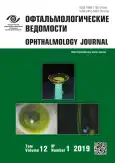Artificial intelligence and machine learning for optical coherence tomography-based diagnosis in central serous chorioretinopathy
- Authors: Kulikov A.N.1, Malahova E.Y.2, Maltsev D.S.1
-
Affiliations:
- S.M. Kirov Military Medical Academy
- Pavlov Institute of Physiology Russian Academy of Sciences
- Issue: Vol 12, No 1 (2019)
- Pages: 13-20
- Section: Original study articles
- URL: https://journals.rcsi.science/ov/article/view/10997
- DOI: https://doi.org/10.17816/OV2019113-20
- ID: 10997
Cite item
Abstract
The aim of the present study was to examine the potential of machine learning for identification of isolated neurosensory retina detachment and retinal pigment epithelium (RPE) alterations as diagnostic criteria of central serous chorioretinopathy (CSC).
Material and methods. Patients with acute CSC in whom a standard ophthalmic examination and optical coherence tomography (OCT) using RTVue-XR Avanti (Angio Retina HD scan protocol, 6 × 6 mm) was performed were included in the study. 10-μm en face slab above the RPE layer was used to create ground truth masks. Learning aims were defined as identification of 3 classes of structural abnormalities on OCT cross-sectional scans: class 1 – subretinal fluid, class 2 – RPE abnormalities, and class 3 – leakage points. Data for each of the 3 classes included: 4800/1400 training/test images for class 1, 2000/802 training/test images for class 2, and 1504/408 training/test images for class 3. Unet-similar architecture was used for segmentation of abnormalities on OCT cross-sectional scans.
Results. Analysis of test sets revealed sensitivity, specificity, precision, and F1-score for detection of subretinal fluid of 0.61, 0.99, 0.99, and 0.76, respectively. For detection of RPE abnormalities sensitivity, specificity, precision, and F1-score were 0.14, 0.95, 0.94 and 0.24, respectively. For detection of leakage point sensitivity, specificity, precision, and F1-score were 0.06, 1.0, 1.0, and 0.12, respectively.
Conclusions. Thus, machine learning demonstrated high potential in the OCT-based identification of structural abnormalities associated with acute CSC (neurosensory retina detachment and RPE alterations). Topical identification of the leakage point appears to be possible using large learning sets.
Full Text
##article.viewOnOriginalSite##About the authors
Alexey N. Kulikov
S.M. Kirov Military Medical Academy
Email: alexey.kulikov@mail.ru
SPIN-code: 6440-7706
MD, PhD, DMedSc, Professor, Head of the Department
Russian Federation, Saint PetersburgEkaterina Yu. Malahova
Pavlov Institute of Physiology Russian Academy of Sciences
Email: katerina.malahova@gmail.com
Associate Researcher
Russian Federation, Saint PetersburgDmitrii S. Maltsev
S.M. Kirov Military Medical Academy
Author for correspondence.
Email: glaz.med@yandex.ru
ORCID iD: 0000-0001-6598-3982
MD, PhD, ophthalmologist of the Ophthalmology Department
Russian Federation, Saint PetersburgReferences
- Gargeya R, Leng T. Automated identification of diabetic retinopathy using deep learning. Ophthalmology. 2017;124(7):962-969. https://doi.org/10.1016/j.ophtha.2017.02.008.
- Daruich A, Matet A, Dirani A, et al. Central serous chorioretinopathy: Recent findings and new physiopathology hypothesis. Prog Retin Eye Res. 2015;48:82-118. https://doi.org/10.1016/j.preteyeres.2015.05.003.
- Maltsev DS, Kulikov AN, Chhablani J. Topography-guided identification of leakage point in central serous chorioretinopathy: a base for fluorescein angiography-free focal laser photocoagulation. Br J Ophthalmol. 2018;102(9):1218-1225. https://doi.org/10.1136/bjophthalmol-2017-311338.
- Бойко Э.В., Мальцев Д.С. Фокальная навигационная лазерная коагуляция сетчатки с помощью ОКТ-картирования // Вестник офтальмологии. – 2016. – Т. 132. – № 3. – С. 56–60. [Boyko EV, Mal’tsev DS. En face’ optical coherence tomography guided focal navigated laser photocoagulation. Annals of ophthalmology. 2016;132(3):56-60. (In Russ.)]. https://doi.org/10.17116/oftalma2016132356- 60.
- Maltsev DS, Kulikov AN, Chhablani J. Clinical application of fluorescein angiography-free navigated focal laser photocoagulation in central serous chorioretinopathy. Ophthalmic Surg Lasers Imaging Retina. [In Press]
- Xiang D, Tian H, Yang X, et al. Automatic segmentation of retinal layer in OCT images with choroidal neovascularization. IEEE Trans Image Process. 2018;27(12):5880-5891. https://doi.org/10.1109/TIP.2018.2860255.
- Khalid S, Akram MU, Hassan T, et al. Fully automated robust system to detect retinal edema, central serous chorioretinopathy, and age related macular degeneration from optical coherence tomography images. Biomed Res Int. 2017;2017:7148245. https://doi.org/10.1155/2017/7148245.
- Wu M, Fan W, Chen Q, et al. Three-dimensional continuous max flow optimization-based serous retinal detachment segmentation in SD-OCT for central serous chorioretinopathy. Biomed Opt Express. 2017;8(9):4257-4274. https://doi.org/10.1364/BOE.8.004257.
- Ronneberger O, Fischer P, Brox T. U-Net: Convolutional networks for biomedical image segmentation. In: Medical image computing and computer-assisted intervention – MICCAI 2015. MICCAI 2015. Lecture notes in computer science. Vol. 9351. Ed. by N. Navab, J. Hornegger, W. Wells, A. Frangi. Cham: Springer; 2015. https://doi.org/10.1007/978-3-319-24574-4_28.
Supplementary files









